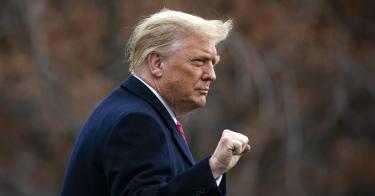By every measure, President Donald Trump, working hand in hand with Mitch McConnell, has accomplished an incredible feat in appointing judges to the federal bench. Besides his three Supreme Court appointees—more than any president in recent years except Ronald Reagan—he has appointed 231 federal judges.
That's more than any president has appointed in his first term since Jimmy Carter. Only George W. Bush and Bill Clinton come close with 204 and 203 judicial appointees, respectively.
Of Trump's nominees, 54 were appointed to the powerful Circuit Courts of Appeals. These judges—almost a third of all full-time circuit judges—will shape the legal landscape of the country for decades and will likely rein in a Biden administration if it succumbs to the temptation of executive overreach.
Although the federal circuit courts are inferior to the Supreme Court, they effectively have the last word on the vast majority of important legal issues percolating through the federal system because the Supreme Court hears, on average, only 76 cases per year. That means that if you want to know what effect the judiciary will have on a presidency, the first place you ought to look is the circuit courts.
So what do Trump's circuit court appointees mean for a Biden administration?
To answer that, we'll have to look at who the appointees are and, most importantly, how they think.
First, Trump's circuit court appointees are young; they average 48 years old. They will all be on the bench long after Biden is out of office. They also come from diverse educational and geographic backgrounds. They are not all cut from the coastal and Ivy League cloth typical among federal judges. Neither are they all former prosecutors or partners at giant law firms.
>>> Judicial Appointment Tracker
Moreover, their qualifications are sterling. Even the American Bar Association, which has a well-documented bias against Republican-appointed judges (see here, here, here and here), has rated them "well qualified" at almost the highest rate in 50 years.
Liberal pundit Ian Millhiser had to concede—much to his chagrin, no doubt—that "[b]ased solely on objective legal credentials, the average Trump appointee has a far more impressive résumé than any past president's nominees."
To put it simply: They're smart. Really smart.
They're also staunch judicial conservatives. That's different from political conservatives. They may well be politically conservative; I do not know. And if you read their judicial opinions, you won't either. The hallmark of judicial conservatism is, as then-professor Amy Coney Barrett explained, that the judge will apply the law as written and avoid imposing his or her personal preferences on it.
That means that these judges can be counted on to prevent the Biden administration from rewriting old laws with new progressive meanings that that run counter to the text. Likewise, these judges can be counted on not to rewrite old laws themselves according to the trendy political views of the day.
That job, these judges will rightly say, is for Congress alone. After all, when a judge rewrites a law to fit his or her personal views, it loses its democratic legitimacy.
In other words, the hallmark of judicial conservatism is a reluctance on the part of judges to use their power outside its area of expertise: saying what the law is.
But here is where Trump's "new" judicial conservatives differ from the "old" judicial conservatives of past Republican presidents. Although they will not expand the judicial power beyond its mandate, they will defend it more strongly that the old judicial conservatives did.
This comes into play clearly in the field of administrative law—the law that governs how executive agencies, the "fourth branch" of government, operate. This field of law, more than any other, is where Trump's judicial appointments and Biden's administration will face off.
Executive agencies wield a strange amalgam of the three governmental powers—legislative, executive and judicial—that the Constitution separated at the nation's founding. They can write, enforce and interpret laws, and sometimes impose penalties for violations of them. Because they are part of the executive branch, constitutional problems arise when they write and interpret laws.
Writing laws is Congress's job, but for years, old judicial conservatives were largely content to allow executive agencies to take as much of that power as Congress gave them. Interpreting laws is the courts' job, but again, old judicial conservatives were largely content to allow agencies nearly free rein in interpreting laws.
That trend is changing. At the Supreme Court, Trump appointees Justices Neil Gorsuch and Brett Kavanaugh have taken a harder line against overreaching executive agencies (for example, here and here) and reasserted the Constitution's commitment to the separation of powers.
Many of Trump's lower-court nominees are taking the same approach, and as such, Biden's executive agencies can anticipate that the judiciary will begin to restrict their powers if they stray beyond their proper realm.
Lastly, Trump's new judicial conservatives differ from old judicial conservatives in their willingness to fix the mistakes of past activist judges.
When old judicial conservatives found themselves in a position to correct cases decided not by law but by policy preferences, they were often afraid to correct them and preferred instead to try (usually in vain) to limit them.
Think of Roe v. Wade, a case that, to this day, no scholar has been able to convincingly defend on constitutional grounds. It's pure policy. But old judicial conservatives—like Justice Sandra Day O'Connor and Chief Justice John Roberts—preserved it because they feared the political fallout of returning the issue to the states as the Constitution demands.
But for the new judicial conservatives, political concerns play no role. They often follow Justice Clarence Thomas's approach and maintain that the judiciary's role is to get the law right, even if the process of correcting old mistakes is politically messy.
That means the Biden administration cannot count on the courts to preserve the politically driven decisions of the past.
In short, Biden is looking at a judiciary that will take seriously the separation of powers and will not let itself become a policy-making body. Whether such a judiciary will be hostile to Biden is entirely up to him.
This piece originally appeared in Newsweek




